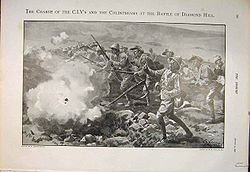Battle of Diamond Hill
| Battle of Diamond Hill | |||||||
|---|---|---|---|---|---|---|---|
| Part of Second Boer War | |||||||
 The Charge of the City of London Imperial Volunteers ('CIVs') and Coldstreams at the Battle of Diamond Hill, after a drawing by William Barnes Wollen |
|||||||
|
|||||||
| Belligerents | |||||||
|
|
|
||||||
| Commanders and leaders | |||||||
|
General Ian Hamilton |
|
||||||
| Strength | |||||||
| 14,000 British soldiers and 70 guns | 4,000 men and 22 guns | ||||||
| Casualties and losses | |||||||
| 162 killed and wounded | 50 killed and wounded | ||||||
The Battle of Diamond Hill (Donkerhoek) took place on 11 and 12 June 1900 during the Second Boer War. Fourteen thousand British soldiers squared up against four thousand Boers and forced them from their positions on the hill. The British cavalry were under the command of Sir Ian Hamilton. He despatched Robert Broadwood's 2nd Cavalry brigade, which included the 10th Royal Hussars, 12th Royal Lancers and the Household Cavalry Regiment, on a Special Mission.
As the sun came up it was a "bitterly cold Monday morning...we are hidden in the hills at Donkerhoek...ready for battle..." confided Botha to his diary.
As a detachment of 10th Hussars swung off to the right, they were attacked from Diamond Hill. A section of Q Battery RHA attempted to return artillery fire, but had no infantry support, until the 12th Lancers arrived on the front line. Lord Airlie took 60 men to clear the Boers from the guns, and in the ensuing exchange of rifle fire at short-range, Lord Airlie was killed. The Boers pressed the matter hard. Two squadrons of Household Cavalry Regiment and one squadron of the 12th Hussars charged at full gallop at Boers firing from concealed positions. The enemy dispersed.
On 13th the Botha's army retreated to the north, they were chased as far as Elands River Station, only 25 miles from Pretoria, by Mounted Infantry and De Lisle's Australians.
Forty-four years after the battle, British General Ian Hamilton opined in his memoirs that "the battle, which ensured that the Boers could not recapture Pretoria, was the turning point of the war". Hamilton credited Winston Churchill with recognizing that the key to victory would be in storming the summit, and risking his life to signal Hamilton.
...
Wikipedia
